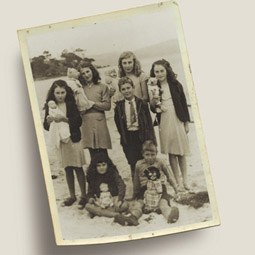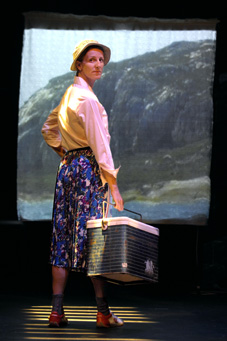 |
Maria Island school children, c1930, Anne Christie collection |
Along with its Indigenous occupants, Maria Island has hosted inhabitants from a parade of countries throughout its extraordinary history including Holland, France, England, Italy and New Zealand. Devised to weave music, poetry, video projection and spoken word, the show tells the story of Maria Island through the recollections of Vega Bernacchi, the daughter of an Italian entrepreneur, and a host of other characters. Accompaniment is by local group Silkweed, on violin, accordion, keyboards, cello, percussion and voice, and whose members are woven into the story telling. Apart from a dancing couple who appear towards the end of the show, the musicians and narrators all stay in place, concert-style for the duration.
For Vega Bernacchi (Sarah Cooper), Maria Island was her first playground. She recalls her delight with the sound of the Indigenous name of the island and childhood re-enactments of the penal settlement era. She is nostalgic for the time when her parents farmed wine and olives and her own life as an adult on the island. Against a projected backdrop of historic images, family photographs, paintings and present day landscape shots, we hear snatches of letters and reports from French explorers, English convicts and their captors, Moari martyrs, an Irish political prisoner and Diego Bernacchi whose dreams for Maria seem to be the inspiration for the show’s name. The male characters are played by Les Winspear. Silkweed build the atmosphere with delicate tunes and folk songs that flesh out the emotions of the events. There is a sense of completeness to the story—we see the life of Maria Island go from uninhabited to agricultural and semi-industrial and then back to nature—as a reserve. Maria Island of Dreams is comfortable, polite—a multimedia recital.
 |
Cheryl Wheatley, Queen of the Snakepit photo Michael Rayner |
For the hour of the performance, Lois is all of the women of Flinders as they watch their men come and go from the sea. She morphs into Queenie (the Queen of play’s title), her aunt Myrtle, and herself as a child. Queenie and Myrtle are tough, wise and very rough around the edges. Just like the tides, these women represent the ebb and flow of island life. While Queenie has spent her adulthood giving birth to islanders (eleven children in all) and seeing her men off to sea, Myrtle bears witness at the other end of life, making wreaths for the dead from “the old flowers, that most people call weeds” along with slaughtering as many feral cats as she can get her hands on. Wheatley’s characterisations of these women are both humorous and poignant. We laugh at Queenie screaming for her beer from the Snakepit (a nickname for the Ladies’ Lounge at the Whitemark Hotel), while also registering her grief: “You should never have to bury your children. They should bury you.” Like breaks between chapters, Lois builds a shrine throughout the show that is composed of important objects or island symbols. There are the trees that “grow sideways like the people”, the nautilus shells that keep time, and the ever present snakes that seem to represent fear, wisdom and longevity.
Maria Island of Dreams and Queen of the Snakepit use varying degrees of characterisation to provide insights into the histories and cultures of the islands. Cooper’s playing of Vega Bernacchi is critical to shifting Maria Island of Dreams away from being simply a historic summary. Vega’s obvious affection for the various lives of the island, including her own, is clearly communicated, yet there is still a sense of distance with this recital-style telling that leaves the audience back on the mainland. I can now answer a whole series of questions about Maria and can visualise its topography, but I don’t feel as though I’ve visited. Lois’ tour however does take us to Flinders Islands: there is an uncomfortable sense that we are stuck in the Whitemark Hotel with her and Queenie. Unfortunately the dramatic structure of the play is too loose, some characters are under-developed and the components of audience participation, including getting two people to blow up kangaroos, seem a distraction from the core idea. I come away with an abstracted image of Flinders Island as a place, but feel as though I’ve imbibed some of the longings, sadnesses and frustrations of the Islanders.
I’m a little uncertain about this documentary style of performance because it hangs on the edge of being touristic. That aside, perhaps the shows need to swap directors for a day making Maria Island of Dreams more engaging and less polite and Queen of the Snakepit more rigorously structured, and with more background information, so that their audiences could live a fuller hour of life on these islands.
Maria Island of Dreams, vocals & accordion Erin Collins, keyboard & flute Susan McGowan, violin & banjo Marjorie Gadd, cello Anna Spinaze; The Barn, Rosny Historic Centre, March 30-31; is theatre, Queen of the Snakepit, deviser/performer Cheryl Wheatley, co-director/dramaturg Robin Laurie, writer Finegan Kruckemeyer, co-director Tania Bosak, designer Greg Methé, executive producer Ryk Goddard; The Backspace Theatre, Hobart, March 29-3; Ten Days on the Island
© Judith Abell; for permission to reproduce apply to [email protected]








 back
back